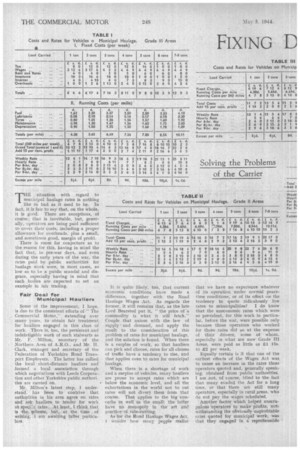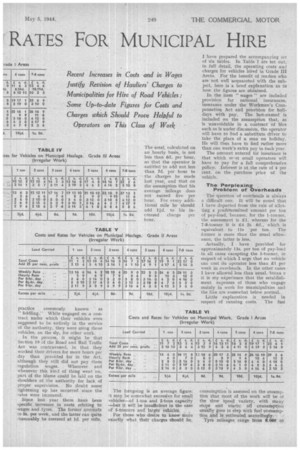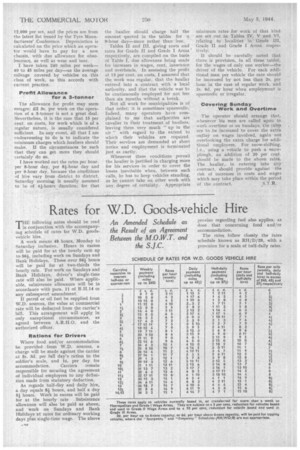FIXING D
Page 26

Page 27

Page 28

If you've noticed an error in this article please click here to report it so we can fix it.
RATES FOR MUNICIPAL HIRE
Recent Increases in Costs and in Wages Justify Revision of Hauliers' Charges to Municipalities for Hire of Road Vehicles : Some Up-to-date Figures for Costs and Charges which Should Prove Helpful to Operators on This Class of Work
MITE situation with regard to 1 municipal haulage rates is nothing like se bad as it used to be. In fact, it is fair to say that, on the whole, it is good. There are exceptions, of course; that is inevitable, but, generally, operators are being paid sufficient to cover their costs, including a proper allowance for overheads; plus a small, and sometimes good, margin of profit. There is room for conjecture as to the reason for this, having in mind the fact that, in pre-war days, and even during the early years of the war, the rates paid by public authorities for haulage work were, in most cases, so low as to be a public scandal and disgrace, especially having in mind that such .bodies are expected to set an example its fair trading.
Fair Deal for Municipal Hauliers
Some oi the Improvement. I hope,: is due to the consistent efforts of " The Commercial Motor," extending over many years, to obtain fair treatment for hauliers engaged in this class of work. There is, too, the persistent and indefatigable work of such stalwarts as Mr. F. Milton, secretary of the Northern Area of A.R.O., and Mr. U. -Clark, manager and secretary of the Federation of Yorkshire Road Transport Employers. The latter has rallied the local short-distance hauliers and formed a local association through which negotiations with Leeds Corporation and other Yorkshire public authorities are carried on.
Mr. Milton's latest step, I understand, has been to contrive that authorities in his area agree on rates and ask hauliers to tender for work at specil:c !ales. At least,, I -think that is the Scheme, but,at :.the. time of writing, I am aWaiting fuller. partieulars.
It is quite likely, too, that current economic conditions have made a difference, together with the Road Haulage Wages Act. As regards the former, it still remains that, as the late Lord I3earsted put it, " the price of a commodity is what it will fetch." Couple that axiom with the law of supply and demand, and apply the result to the consideration of this problem of rates for municipal haulage, and the solution is found. When there is a surplus of work, so that hauliers can pick and choose, rates for all classes of traffic have a tendency to rise, and that applies even to rates for municipal haulage.
When there is a shortage of work and a surplus of vehicles, many hauliers are prone to accept rates which are below the economic level, and all the exhortations in the world not to cut rates Will not divert them from that course. That applies to the big 'con-. cerns as well as the small; the latter have no monopoly in the art and practice' of: rate-tutting: .
As Jor the Road Fla tilage, Wages Aet, I Wonder how many pe9ple realize
that we have no experience whatever of its operation under normal peacetime conditions, or of its effect on the tendency to quote ridiculously low rates to municipalities? I do know that the uneconomic rates which were so prevalent, for this work in particular, before the war, were possible onlybecause those operators who worked for those rates did so at the expense of their drivers, some of whom, especially in What, are now Grade III Areas, were paid as little as £1 153, to £2 per week.
Equally certain is it that one of the earliest effects of the Wages Act was to cause an increase in the rates these operators quoted and, generally speaking; obtained from public authorities. I am not, of course, blind to the fact that many evaded the Act for a long time, or that there are still many operators, especially in rural Areas, who do not pay the Wages Scheduled.
Another factor which helped unscrupulouS 'operators to make' profits, notwithstanding the obviously unprofitable rates quoted for municipal work, was that they engaged in a reprehensible practice commonly known as " fiddling." While engaged on -a contract under which their vehicles were supposed to be entirely in the service of the authority, they were using those vehicles, on the sly, for other work.
In the process, it might be that Section 19 of the Road and Rail Traffic Act was contravened, in that they worked their drivers for more hours per day than provided for in the Act, although they still did not pay them regulation wages. Wherever and whenever this kind of thing went on, part of the blame could be laid on the shoulders of the authority for lack of proper supervision. No doubt some tightening up has occurred since the rates were increased.
Since last year there have been specific increases in costs relating to wages and tyres. The fotther amounts to 5s, per week, and the latter can quite reasonably be assessed at Id. per mile. The total, calculated on an hourly basis, is not less than 6d. per hour, so that the operator is entitled to add not less than 7d. per hour to the charges he made last year, and that on the assumption that his average mileage does not exceed five per hour. For every additional mile he should add lid. to his increased charge per hour.
The foregoing is an average figure; it may be somewhat excessive for small vehicles-of 1-ton and 2-tons capacity -but it will: be insufficient in the cate of 5-tonners and larger vehicles.
For those who desire to know more exactly what their charges should be, I have prepared the accompanying set of six tables. In Table I are set out, in full detail, the operating costs and charges for vehicles hired in Grade Ili Areas, For the benefit of readers who are not well acquainted with the subject, here is a brief explanation as to how the figures are obtainerL In the item " wages " are included provision for national insurances, insurance under the Workmen's Compensation Act and provision for holidays with pay. The last-named is included on the assumption that, as is unavoidable in a contract of lure such as is under discussion, the operator will have to find a substitute driver to take the place of a man on holiday. He will thus have to find rather more than one week's extra pay in each 'year.
The amount entered for insurance is that which rry-,st small operators will have to pay for a full comprehensive policy-. Interest is at .the rate of 4 Per cent. on the purchase price of the vehicle.
The Perplexing Problem of Overheads
The question of overheads is always a difficult one. It will he noted that I have departed from the rule of allotting. a predetermined amount per ton of pay-load, because, for the 1-tonner, the assessment is £1, whereas for the 7-8-tonner it is £4 2s. 6d., which is equivalent to us per ton. The former is snore than the usual allowance, the latter is less.
Actually. I have provided for approximately I ls. per ton of pay-load in all cases excepting the 1-tonner, in respect of which I urge that no vehicle can cost its operator less than £1 per week in overheads. In the other cases I have allowed less than usual, becau e it is my eXperience that the establishment expenses of those who engage mainly in work for municipalities and the like are somewhat below normal.
Little explanation is needed in respect of running costs. The fuel consumption is assessed on the atsumption. that most of the work will be ,ol the slOw speed variety, with 'many stops arid starts: oil consuinption usually goes in step with fuel consumption and is estimated accordingly. Tyre mileages range from 8,090 tO 12,000 per set, and the prices are from the latest list issued by the Tyre Manufacturers' Conference, Depreciation is calculated on the price which an operator would have to pay for a new chassis, with due allowance for obsolescence, as well as wear and tear.
I have taken 240 miles per week40 to 45 miles per day—as the average mileage covered by vehicles on this class of work, as this accords with current practice.
Profit Allowance for a 3-tonner The allowance for profit may seem meagre: £2 3s, per week on the operation of a 3-tonner is not a great deal. Nevertheless, it is the case that 15 per cent, on costs, for work which is of a regular nature, is usually considered sufficient. In any event, all that I am endeavouring to do is to indicate the minimum charges which ,hauliers should make. If the circumstances be such that they can get more they should certainly do so.
have worked out the rates per hour, per 8-hour day, per 81--hour day and per 9-hour day, because the conditions of hire vary from district to district. Saturday mornin,g iS usually assumed to be of 44.-hours duration; for that the .haulier should charge half the amount quoted in the tables for a 9-hour day—more rather than less,
Tables II and III, giving costs and rates for Grade II and Grade I Areas respectively, are compiled on the basis of TableI, due allowance being made for increases in wages, rent, insurance and overheads. In assessing the profit at 15 per cent, on costs, I assumed that the work was regular, that the haulier entered into a contract with a local authority, and that the vehicle was to be continuously employed for not less than six months without a break.
Not all work for municipalities is of that order; it is sometimes spasmodic-. Indeed, many operators have complained to me that authorities are cavalier in their treatment of hauliers, leaving them very much " up in the air " with regard to the extent to which their vehicles are required. Their services are demanded at short notice and employment is terminated just as curtly.
Whenever these conditions prevail the haulier is justified in charging more for his servicesin order to cover the losses inevitable when, between such calls, he has to keep vehicles standing, as he cannot take on other work with any degree of certainty. Appropriate minimum rates for work of that kind are set out in Tables IV, V and VI, relating to localities in Grade HI, Grade II and Grade I Areas respectively.
It should be carefully noted that there, is provision, in all these tables, for the wages of only one worker--the driver of the vehicle. For each additional man per vehicle the rate should be increased by not less than 2s. per hour in the case of regular work, and 2s. 6d. per hour when employment is spasmodic or irregular.
Covering Sunday Work and Overtime :rho operator should arrange that, whenever his men are called upon to work overtime or on Sundays, the rate are 'to he increased to cover the extra outlay on wages involved, again not overlooking the extra charge for additional employees. For snow-shifting, i.e., using a vehicle to push a snowplough, an addition of 20 per cent. should be made to the above rate. The haulier, in entering into any contract, should provide against the risk of increases in costs and wages which may take place within the period of the contract. 5,1'.R.




















































